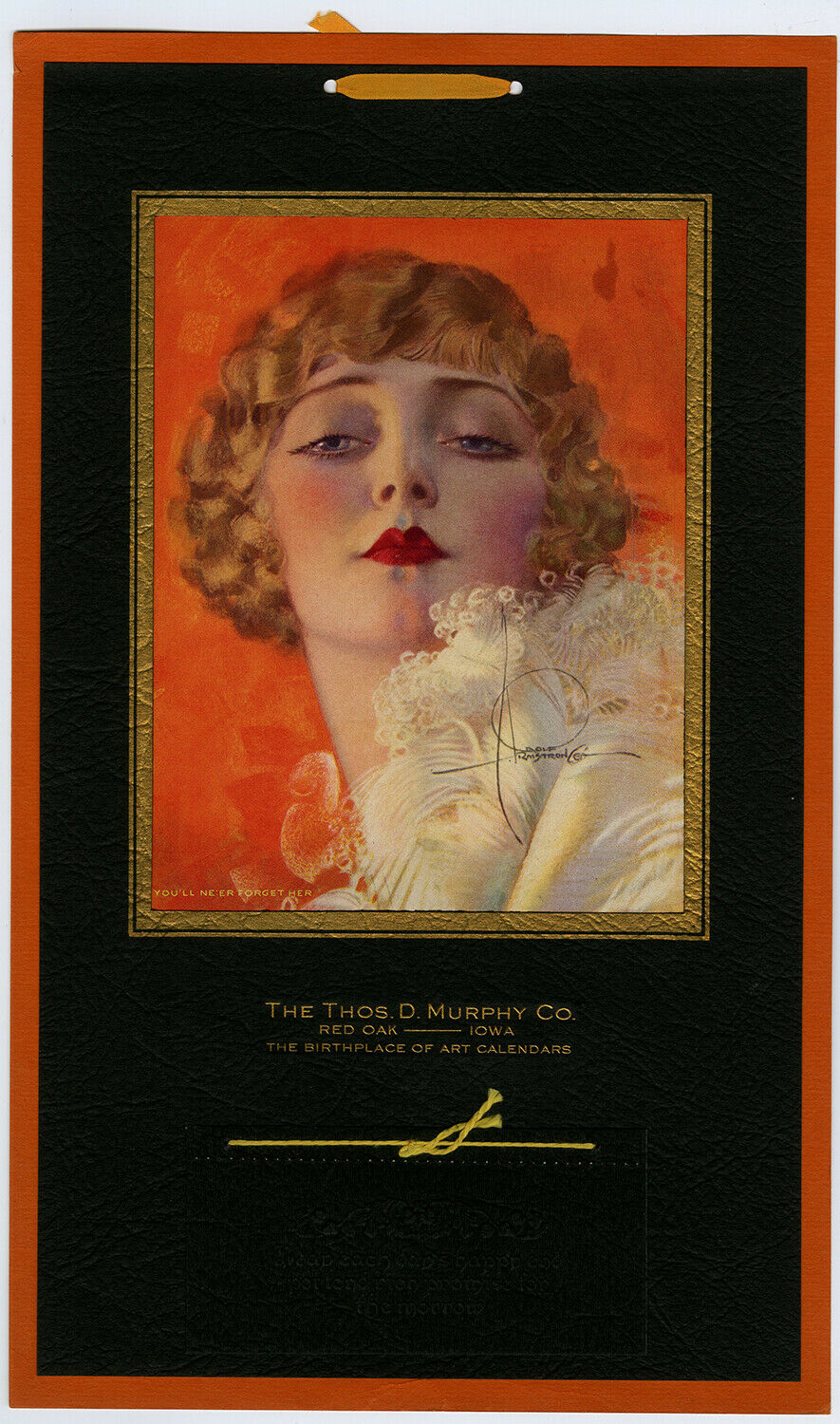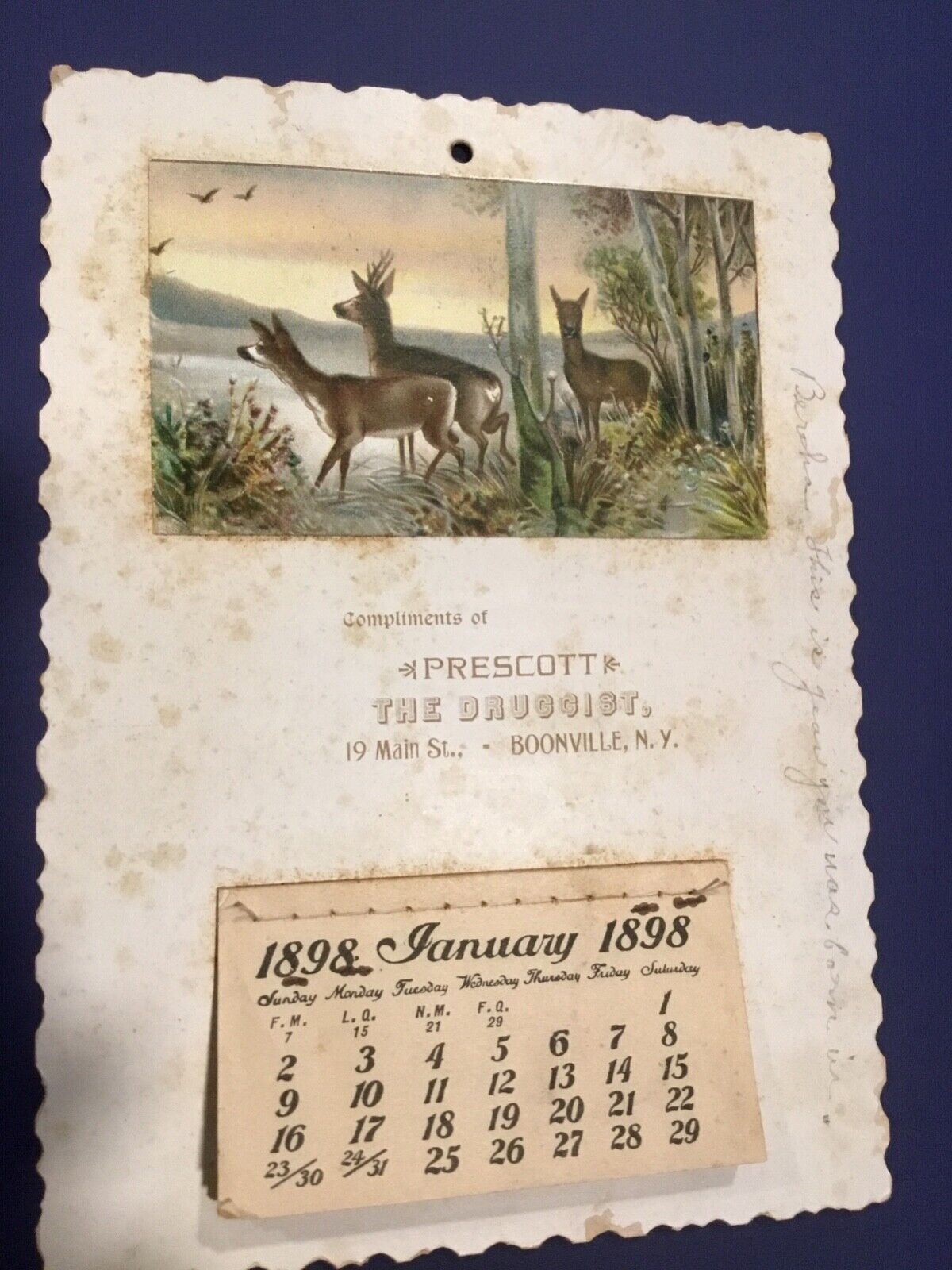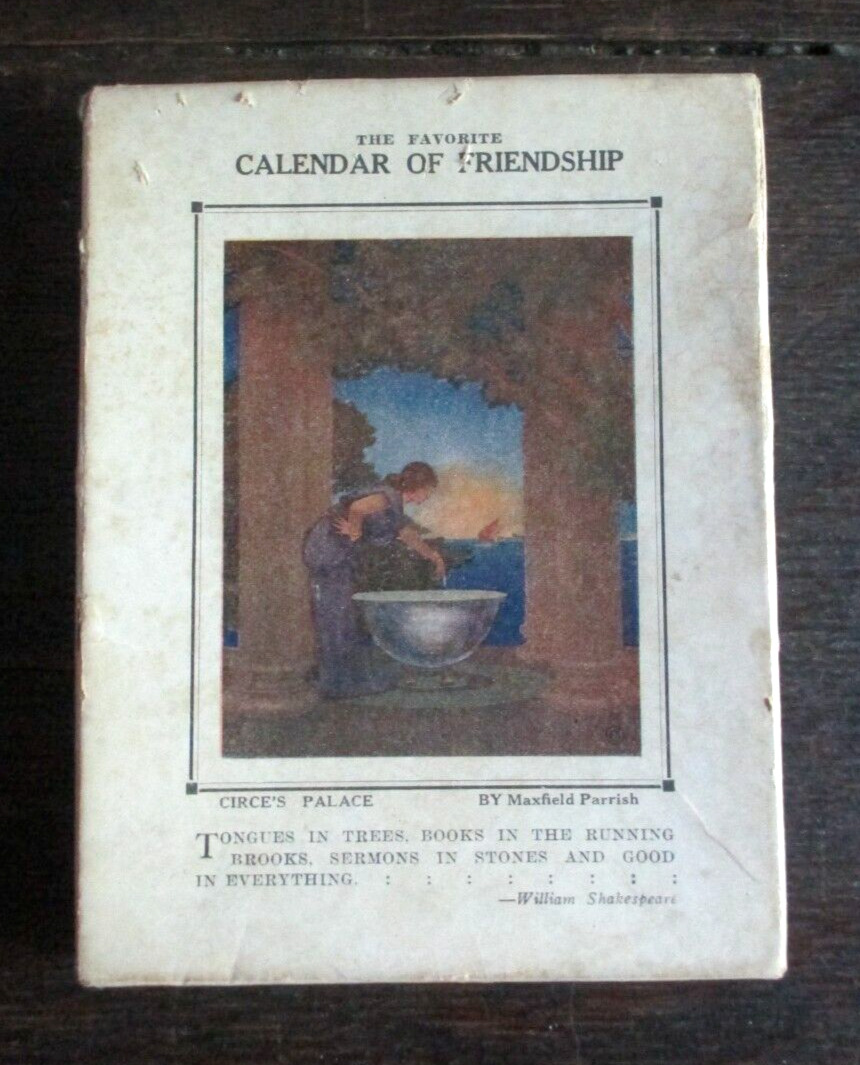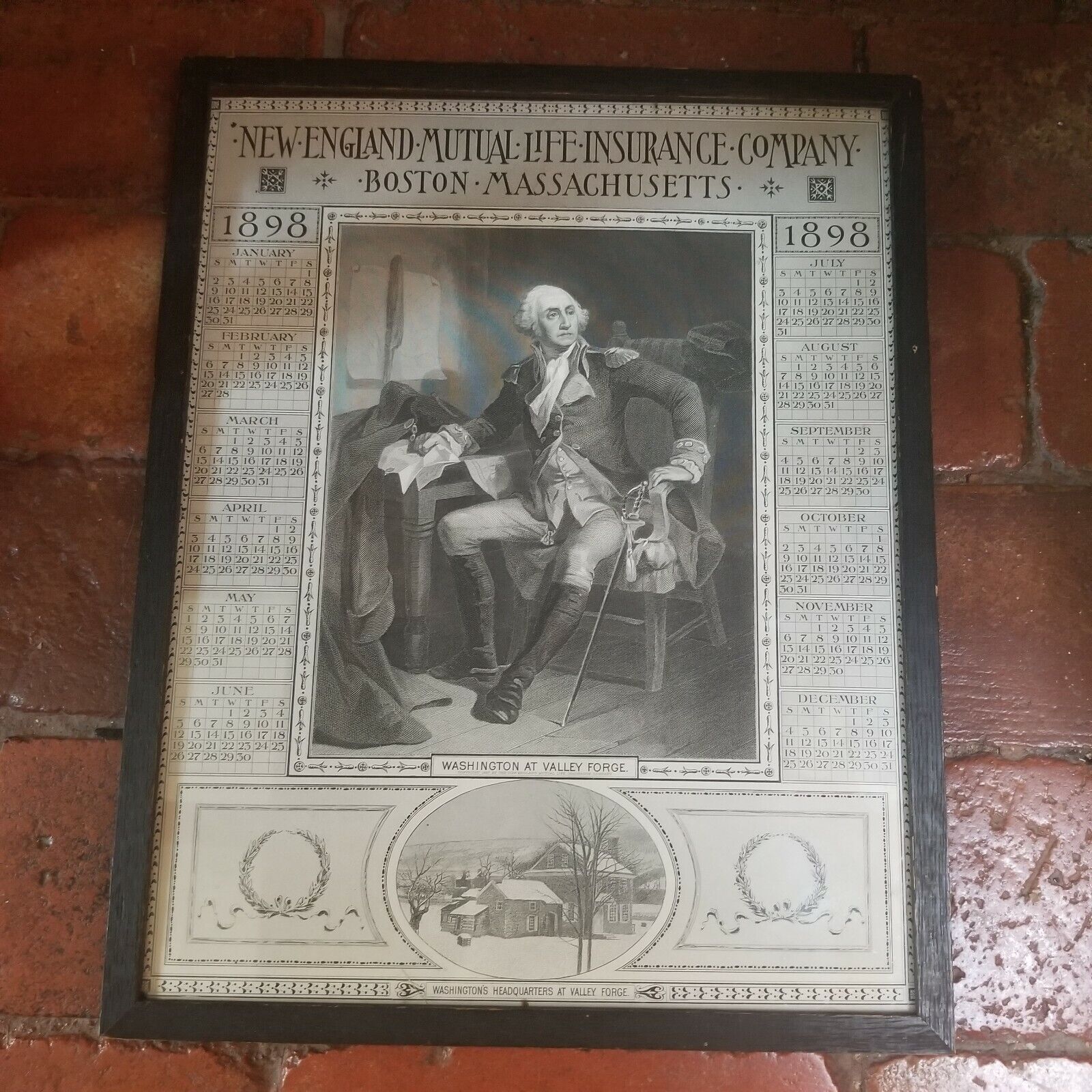-40%
1931 Rolf Armstrong Thos. D. Murphy Advertising Pin-Up Mailing Calendar Sample
$ 4.75
- Description
- Size Guide
Description
ITEM: You are bidding on a vintage original 1931 archived pin up calendar sample with advertising printed for Thos. D. Murphy Co. of Red Oak, Iowa, with a lone January 1931 date pad under a flap. The artwork features a seductive smokey-eyed flapper titled, "You'll Never Forget Her."Measures a complete 8 3/4" x 15". Image area measures 5 3/4" x 7 1/2".
CONDITION: Very fine condition with minor edge and handling wear. Has a lone 1931 January date pad under a flap. Please use the included images as a conditional guide.
Guaranteed to be 100% vintage and original from Grapefruit Moon Gallery.
More about Rolf Armstrong:
In 1946, a newspaper profile coined Rolf Armstrong “the pappy of 165 calendar girls.” Over time, that sentiment crystalized into an understanding of Armstrong as the father of the American pinup. No other figure so perfectly captured the zest and allure of the American girl in her many styles during the first half of the 20th century. As fashion and culture changed, his art responded. Not only did Armstrong reflect the spirit of his times in his work, he embodied them in his life.
The fourth son of a tugboat captain, Armstrong spent his early years in Bay City, Michigan. At 14, after the death of his father, the family relocated to Seattle, where, according to myth-making stories he would tell throughout his life, his artistic spirit was awakened. Skipping school, he would sit out on the docks watching ships coming in. He would sketch the rugged sailors and “gaudy crowd of red light chiselers,” newly aware that his two passions in life were sailing and art.
At 18, he enrolled in the Art Institute of Chicago. He lived with a number of other students, including Thomas Hart Benton, whose unpublished autobiography tells of Armstrong’s enthusiasm for all things bohemian. Rolf encouraged trips to seedy Ragtime clubs, hosted all-night parties at their apartment, even led an expedition to a local brothel—though Benton maintains they did nothing more than look. After art school, Armstrong continued his adventures in New York, first in a studio at the Lincoln Arcade, and soon in Greenwich Village. Talent, shameless self-promotion, and the natural ability of the bon vivant to meet influential people helped Armstrong easily launch his career.
Occasionally, he’d pose for more established artists such as Howard Chandler Christy, testament to the young artist’s consistent ability to end up at the right place in the right time. Before long, he built a reputation as a “pretty girl” illustrator.
Armstrong’s early work is filled with references to the cutting edge of fashion and style, and tracks the advent of the flapper like a time-lapse movie. His vision was so particular he applied the make- up on his models himself. By the time his wildly sophisticated, kaleidoscopic, floating heads had become a staple of magazine and sheet music covers, it was impossible to be sure whether he was following trends or creating them. The artist’s theatrical, decadent style formed part of the allure of the spider-lashed, boldly-adorned “Armstrong girl” who appeared on more than a hundred magazine covers, as well as in advertising campaigns and stand-alone calendars.
Armstrong drove exotic cars, raced sailboats, and popped up in society columns documenting the wildest parties. His life seemed intentionally cinematic. Then, there were his looks.
“I met a tall, handsome blonde who looked like the pictures of [handsome boxer] Carpentier,” the actress Agnes Ayres gushed after a Photoplay sitting for the artist, who had previously been described as a “giant [with] massive shoulders towering above a slim waist wrapped in an Apache sash.” The story of a matinee idol libertine glorifying one of jazz age Hollywood’s “it girls” proved irresistible for the many silent film magazines that featured his illustrations.
Then the story changed. In the early 1930s, talkies anointed a new batch of stars, and the Depression made the hedonism of flapper culture seem suddenly frivolous. Alongside the silent film stars whose portraits helped make his name, Armstrong fell out of favor with movie magazines, though his interest in Hollywood continued. In 1933, he and his wife, Louise, followed Rolf’s nephew, Robert Armstrong—an actor best remembered as Carl Denham in King Kong—to California.
Rolf attempted to reinvent himself as an entrepreneur and portrait painter to the stars, through a venture he called Armstrong Art Services, he self-marketed photographs of his art, some of the most risqué and technically sophisticated work to date, playing up the fact that his nudes were indeed “painted from life.” Nothing came of those ventures, and in mid-1939 the artist returned to New York, alone. On December 31, 1939, the Armstrong's divorced. On January 1, 1940, Louise married Rolf’s nephew Robert.
Though the previous decade had been tumultuous, during that time Armstrong had solidified a new reputation as one of the Brown & Bigelow calendar company’s star artists. His 1930s calendar girls were as stylish and fashionable as his earlier work, but now they were full-bodied, impossibly long-limbed, revealingly outfitted, and beaming out smiles that teased rather than seduced. His early art deco pinups are in some ways his most fully realized work, and seemed to be his favorite. As late as the 1950s, snapshots of his studio show a picture of a gauzy blonde nude from this period hanging prominently on the wall. But regarding his career and personal life, what happened when Rolf headed back East turned out to be far more significant.
On his return to New York City, Armstrong moved to the Hotel des Artistes, set up a penthouse studio with his oversized palate of 3,000 pastels, and put out an ad for artists’ models. Among the respondents was Jewel Flowers, a beauty queen from Lumberton, North Carolina. Jewel was Rolf’s opposite and, in many ways, a departure from previous Armstrong girls. A tiny, naive newcomer to the city, she was curvy and dynamic rather than slender and sylph-like, and when the first calendar featuring her (titled “How Am I Doing,”) hit the market, she became a sensation.
Armstrong was quoted as saying it took anywhere from one to three months to complete a pastel. He would start working from a live model, then mimic her pose on a costumed, life- sized antique mannequin with articulated limbs, outfitted with a papier-mâché mask by W.T. Benda. The length of time he worked on each piece, combined with the year or so it took from when a pastel was completed until its publication, meant that Jewel Flowers first appeared as a pinup girl just as the U.S. entered World War II. She quickly became a celebrity, received fan letters from servicemen overseas, and stayed a popular model for Armstrong for the remaining 18 years of his career.
There is a precipitous break between the artist’s pre and post-Jewel work. After 1940, his pinups were more carefree, the costumes more casual, and the bodies significantly curvier. Partially, it reflected the change of taste—nothing was more appealing than the girl next door during wartime—but there was no question that Jewel had become a muse to Rolf, as well as dear friend, personal secretary and confidant. The two were so close that Jewel vacationed with Rolf, sailing to Tahiti and Hawaii, where she spent time with Armstrong’s long-time friend Jimmy Cagney. When Jewel got married and set up house, Rolf gave her recipe tips and doted on her son.
In 1958, when asked to describe the perfect model, Armstrong described a brunette, with no formal modeling or acting training, with “the stars still in [her] eyes and with natural spirit.” The antithesis of the Follies girls and silent film vamps who had launched his career. In other words: Jewel Flowers.
Rolf Armstrong died in Hawaii in 1960.












